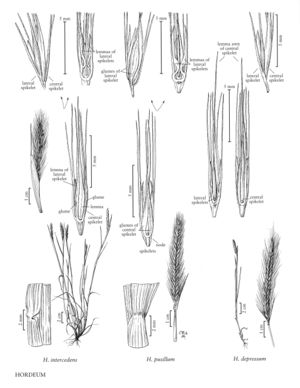Difference between revisions of "Hordeum intercedens"
FNA>Volume Importer |
imported>Volume Importer |
||
| Line 39: | Line 39: | ||
|publication year= | |publication year= | ||
|special status= | |special status= | ||
| − | |source xml=https:// | + | |source xml=https://bibilujan@bitbucket.org/aafc-mbb/fna-data-curation.git/src/bb6b7e3a7de7d3b7888a1ad48c7fd8f5c722d8d6/coarse_grained_fna_xml/V24/V24_342.xml |
|subfamily=Poaceae subfam. Pooideae | |subfamily=Poaceae subfam. Pooideae | ||
|tribe=Poaceae tribe Triticeae | |tribe=Poaceae tribe Triticeae | ||
Revision as of 22:46, 27 May 2020
Plants annual; loosely tufted. Culms 5-40 cm, erect to geniculate; nodes usually pubescent. Sheaths with stripes of hairs; ligules 0.3-0.8 mm; auricles usually absent, shorter than 2 mm if present; blades to 9 cm long, to 4 mm wide, both surfaces sparsely to densely hairy, hairs spreading. Spikes 2.5-6.2 cm long, 4-6 mm wide, often partially enclosed at maturity, pale green. Glumes straight, usually slightly divergent at maturity. Central spikelets: glumes to 17 mm long, to 0.8 mm wide basally, distinctly flattened near the base; lemmas 4.5-7.5 mm, usually sparsely pubescent towards the base, glabrous distally, awned, awns 5.6-9.8 mm, often slightly divergent at maturity; anthers 0.6-1.2 mm. Lateral spikelets usually sterile; glumes to 17.5 mm, distinctly flattened near the base; lemmas 1.7-4.4 mm, blunt to acute, usually unawned, rarely awned, awns to 1.2 mm. 2n = 14.
Discussion
Hordeum intercedens grows in vernal pools and flooded, often saline river beds and alkaline flats. It is restricted to southwestern California, including some of the coastal islands, and northwestern Baja California, Mexico.
Selected References
None.
